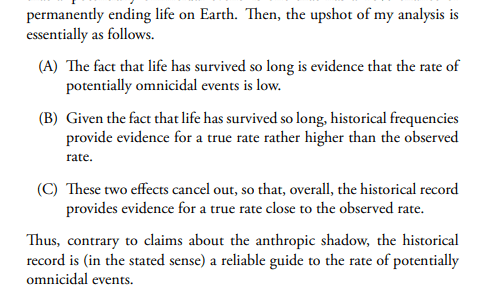This is a linkpost for Dispelling the Anthropic Shadow by Teruji Thomas.
Abstract:
There are some possible events that we could not possibly discover in our past. We could not discover an omnicidal catastrophe, an event so destructive that it permanently wiped out life on Earth. Had such a catastrophe occurred, we wouldn’t be here to find out. This space of unobservable histories has been called the anthropic shadow. Several authors claim that the anthropic shadow leads to an ‘observation selection bias’, analogous to survivorship bias, when we use the historical record to estimate catastrophic risks. I argue against this claim.
Upon a first read, I found this paper pretty persuasive; I'm at >80% that I'll later agree with it entirely, i.e. I'd agree that "the anthropic shadow effect" is not a real thing and earlier arguments in favor of it being a real thing were fatally flawed. This was a significant update for me on the issue.
Anthropic shadow effects are one of the topics discussed loosely in social settings among EAs (and in general open-minded nerdy people), often in a way that assumes the validity of the concept[1]. To the extent that the concept turns out to be completely not a thing — and for conceptual rather than empirical reasons — I'd find that an interesting sociological/cultural fact.


But this example relies on there just being one planet. If there are >1 planets, each with two periods, we are back to having an anthropic shadow again.
Let's consider the case with 2 planets. Let's call them x and y.
According to SSA:
Given A, there are 4 different possibilities, each with probability 1/4:
Let's say you observe yourself to be alive at time-step 2 on planet x.
Pr(x2|A) = 1/4*1/4 + 1/4*0 + 1/4*1/3 + 1/4*0 ~= 0.146
Given B, the probabilities are instead:
Pr(x2|B) = (9/10)^2*1/4 + 9/10*1/10*0 + 1/10*9/10*1/3 + 1/10*1/10*0 ~= 0.233
Pr(A|x2) = Pr(x2|A)Pr(A)/Pr(x2) = Pr(x2|A)Pr(A)/[Pr(x2|A)*0.5+Pr(x2|B)*0.5)] ~= 0.146*0.5/[0.146*0.5+0.233*0.5] ~= 0.385.
According to SIA:
Here, we can directly compute Pr(A|x2).
All x2 observers are:
The total sum of x2 measure in worlds where A is true is 0.5*1/4 + 0.5*1/4 = 0.25.
The total sum of x2 measure is 0.5*1/4 + 0.5*1/4 + 0.5*(9/10)^2 + 0.5*9/10*1/10 = 0.7
Pr(A|x2) = 0.25/0.7 ~= 0.357.
The difference would be somewhat larger with >2 planets. (But would never be very large. Unless you changed the SSA reference classes so that you're e.g. only counting observers at period 2.)
Also: The mechanism of action here is the correlation between there being a survivor alive at x2 and there being a greater number of total observers in your reference class. There are multiple ways to break this:
Overall: I don't think SSA-style anthropic shadows of any significant size are real. Because I think SSA is unreasonable, and because I think SSA with small/restrictive reference classes is especially unreasonable. And with large reference classes, it seems unlikely to me that there are large correlations between our possible historic demise and the total number of observers. (For reasons like the above two bullet points.)